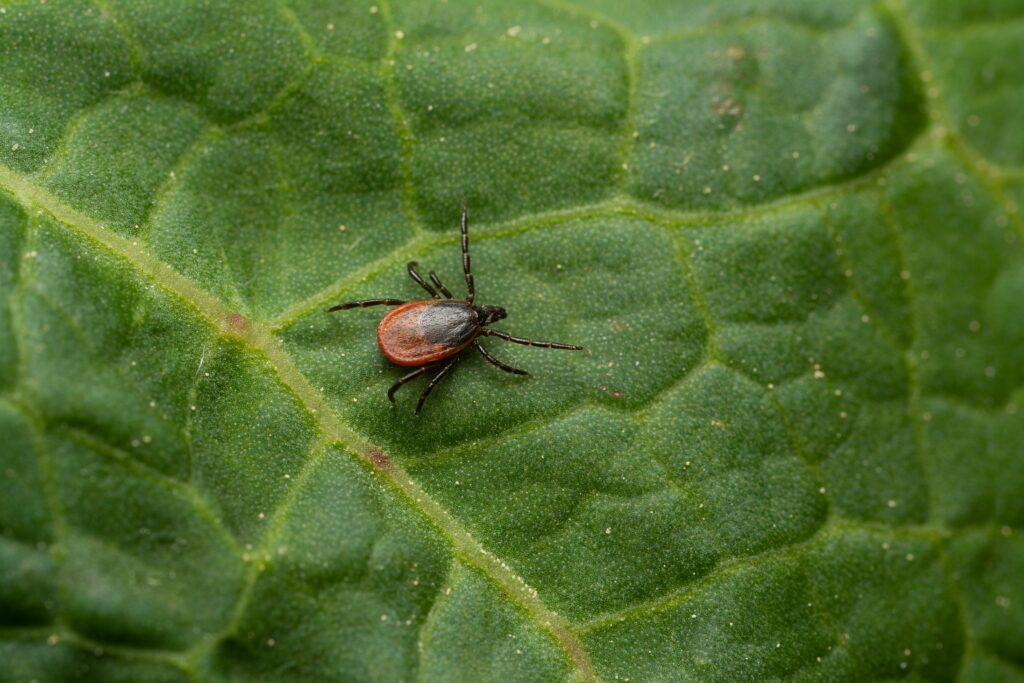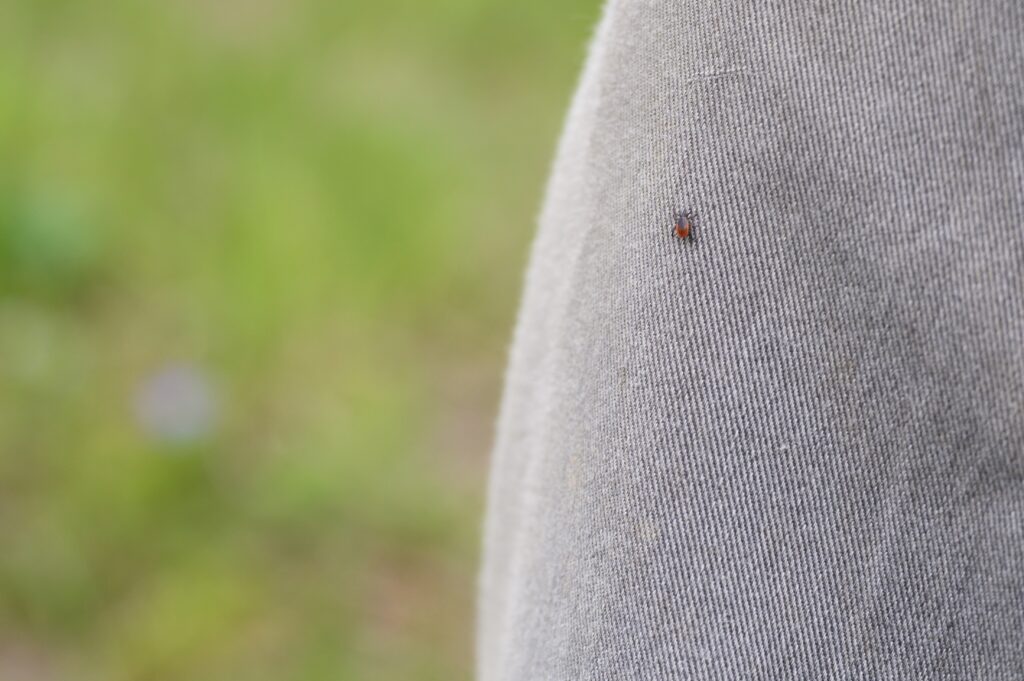
Not all ticks carry the bacterium Borrelia burgdorferi which causes Lyme disease in humans. The proportion of ticks that carry the bacterium Borrelia burgdorferi can change based on their location and specifically on what they have been feeding on. It can be less than 1% in some locations, or more than 50% in others.
Ticks need blood meals to survive. After a tick egg hatches, it goes through the life stages of larva to nymph and nymph to adult. Each of these will try to attach itself to passing animals or humans, as each stage needs a blood meal to move to the next stage. Unlike mosquitoes in which only females seek blood meals, both female and male ticks bite and take blood meals.
Ticks do not have the body parts to allow them to jump or fly. The only way they find their victims is by crawling up grasses and other vegetation and waiting for an animal or human to brush past them. The larva, nymph, and adults all have serrated mouth parts that dig into the victim’s skin and make it difficult to take the tick out once it is latched and feeding. All life stages can carry disease.
Deer ticks often depend on deer as their primary source of food. However, deer don’t get Lyme disease, so they don’t get affected by bites from infected ticks, and they don’t transmit the bacterium to healthy ticks. Ticks most commonly get Borrelia burgdorferi from infected rodents.
Ticks are often found in woodlands, grasslands, and yards. Their most active time is between early spring and fall. During early spring and summer (April-July) tick larvae and nymphs are looking for blood meals. These can be particularly dangerous because they are very small (the size of a poppy seed) and can be hard to spot on the skin. Towards later summer and fall, you will see more adult ticks. In colder weather, they can be found hiding under dead and dry leaves or burrowing deep in the soil. In lab settings, ticks cannot survive in low temperatures from -2 to 14 degrees Fahrenheit, but is understood that in nature, snow, earth, and vegetation gave them enough insulation to last the winter. Their physiology includes a natural “antifreeze” they make in their body during the winter to protect them from freezing and dying.

Types of ticks and tick-borne diseases
In the northeastern and upper midwestern United States, blacklegged ticks (Ixodes scapularis) or deer ticks are primarily responsible for transmitting Borrelia burgdorferi to humans and causing Lyme disease. On the west coast, their close relatives, the western blacklegged tick (Ixodes pacificus) spread Lyme disease. Lyme disease is more common on the U.S. East Coast compared to the West Coast, with the country’s northeast the most affected.
Blacklegged ticks can also transmit pathogens other than Borrelia burgdorferi and cause a variety of diseases such as:
- Anaplasma phagocytophilum which causes a disease called anaplasmosis
- Babesia microti, a microscopic parasite that infects red blood cells and causes a disease called babesiosis.
- Borrelia mayonii which causes Lyme disease
- Borrelia miyamotoi which causes Tick-borne relapsing fever.
- Powassan virus which causes Powassan disease
Other species of ticks can transmit other illnesses such as:
- Soft ticks of the Argasidae family can cause Tickborne relapsing fever. This has been reported in 15 U.S. states and is often associated with people sleeping in rustic woodland vacation homes or cabins.
- The Gulf Coast tick (Amblyomma maculatum) can transmit a parasite called Rickettsia parkeri which causes Rickettsia parkeri rickettsiosis.
- The Rocky Mountain wood tick (Dermacentor andersoni) can transmit the Colorado tick fever virus which causes Colorado tick fever.
- The lone star tick (Amblyomma americanum) can cause a multitude of diseases such as ehrlichiosis (transmitted by several species of the Ehrlichia bacterium), a flu-like illness (transmitted by the Heartland virus), and Southern tick-associated rash illness (transmitted by a bacterium tentatively named Borrelia lonestari).
Despite a number of tick-borne illnesses known, Lyme disease transmitted by blacklegged deer ticks is the most common, affecting an estimated 300,000 people in the U.S. every year. The other infections listed are considered uncommon to rare.

The probability of getting Lyme disease from a tick bite is 0-50%. It really depends on whether or not the tick is infected. Half the ticks tested in some areas can be infected with Borrelia burgdorferi, which causes Lyme disease.
Prevention tips for avoiding tick bites
To avoid being bit by ticks, avoid going into tick habitat. Avoiding brushing against grasses and vegetation can prevent ticks from landing on your clothing or skin. Treating clothing and camping equipment with 0.5% permethrin can kill or incapacitate ticks that land on them on contact. Showering after returning from a trip in the wilderness is recommended to wash off any unattached ticks from your body. A careful examination of your body for attached ticks is important if you have been into a tick-infested area.
Tick habitat could be right in your backyard. Keeping the yard clean of long grasses, dead leaves, and other debris, and spraying with insect repellents can prevent large populations of ticks from growing there. Also preventing deer and other wildlife from wandering in your yard and brushing against your plants can help keep some ticks of the ticks out.
The information provided in our blog posts is for informational purposes only and is not intended as a substitute for professional medical advice, diagnosis, or treatment. Always seek the advice of your physician or other qualified health provider with any questions you may have regarding a medical condition. Never disregard professional medical advice or delay in seeking it because of something you have read on this blog.






